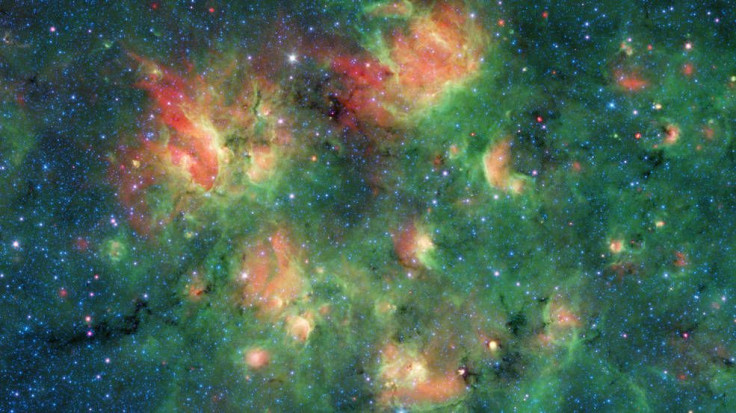NASA Spitzer Captures Stunning Photo Of Milky Way Galaxy Filled With Bubbles

NASA’s Spitzer Space Telescope captured a stunning image of a star-rich region in the Milky Way galaxy filled with bubbles. According to the space agency, each bubble in the region contains hundreds to thousands of stars.
The stellar region that Spitzer spotted lies within the Aquila constellation of Milky Way. In the infrared image captured by the space telescope, the region features massive colorful clouds of gas and dust.
“The colors in this image represent different wavelengths of infrared light,” NASA explained in a statement. “Blue represents a wavelength of light primarily emitted by stars; dust and organic molecules called hyrdrocarbons appear green, and warm dust that’s been heated by stars appears red.”
Among the clouds of gas and dust are bubbles that were inflated by a combination of the wind and radiation emitted by the surrounding young stars. According to NASA, these massive bubbles measure about 10 to 30 light-years across. Unfortunately, since they are very far from Earth, their exact sized cannot be accurately measured.
Cosmic bubbles in the Milky Way! 🌌 This @NASAspitzer image shows a cloud of dust and gas filled with bubbles 10 to 30 light-years across, each containing hundreds of thousands of stars.
— NASA (@NASA) September 30, 2019
📍Click through for an annotated version pinpointing where they are: https://t.co/GvRoIrKFPb pic.twitter.com/MRzOB7HWD4
Although the exact sizes of the bubbles are unknown, NASA noted that each bubble contains hundreds to thousands of stars. The stars within the bubbles were formed by the dense clouds of dust and gas in the region.
Aside from the bubbles and colorful clouds, another prominent feature captured by Spitzer are the bow shocks. These appear as red arcs that were formed fast-moving winds pushed dust particles away from their paths. As the stars pushed away the dust, they generated winds that formed into red arcs.
According to NASA, the discovery of the unique features in the region were made possible through a research project by Zooniverse. This is a collective effort by volunteers and amateur researchers to help professional researchers collect information about the universe.
“The bubbles and bow shocks in this image were identified as part of The Milky Way Project, a citizen initiative on Zooniverse.org that seeks to map star formation throughout the galaxy,” NASA stated.
“Participating citizen scientists looked through images from Spitzer’s public data archive and identified as many bubbles as they could,” the agency added. “More than 78,000 unique user accounts contributed.”
© Copyright IBTimes 2024. All rights reserved.




















